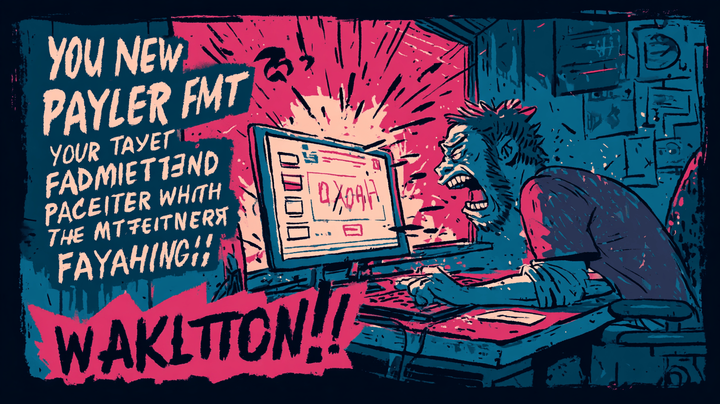Make bad customers sweat

The way in which you design the processes of your company can have a huge impact on your organization.
Every business has to deal with good and bad customers. You don’t need me to elaborate on that.
The good ones are the ones who happily pay for your services, are happy with them, and rarely bother your team. The bad ones are the ones who are always asking for special treatment, complaining about your fees, and leaving bills unpaid.
Process design
In the beginning, when your business is just starting, you just need customers. Your processes are designed to acquire as many customers as possible and keep them, whatever it takes. You do stuff manually for them. communicate with them directly, and even adapt your business to some of your special customers’ needs. You treat each customer as if they are the only ones.
This works, and I am convinced it is essential to have this personalized approach at the beginning, but once the company starts to grow, you need to redesign them.
Once your business is up and running, you should organize all the processes of your company to favor the good customers and punish the bad ones, preventing the latter from adding extra work for your team and causing you headaches.
In this post, I am going to illustrate how a small change in our billing system not only reduced significantly the amount of work of the Customer Support and Accounting departments of my company, but increased the average monthly revenue per customer, all thanks to a subtle but important conceptual change in our payment system and a little bit of automation.
Bad customers and payments
The revenue of Companio comes mainly from the monthly fee for our accounting, taxes, and compliance services. Each month, you pay a fee based on your number of invoices that month. The billing cycle happens always on the 25th of every month.
In an ideal world, all payments for your services go through perfectly. However, in the real world, shit happens. Credit cards expire, some customers don’t have enough money in their accounts, and some others may refuse to pay for your services.
Before the beginning of this year, if one of the payments of a customer failed, the Customer Support department would contact that customer and inform them of the situation. In that ideal world I mentioned before, all customers are good customers, everybody gets your emails, and as soon as they realize a payment failed, they do whatever’s needed to retry the payment.
Turns out, that ideal world does not exist. Most customers –fortunately– are good customers, but many others are lazy, don’t read your emails, or don’t care if there are unpaid invoices, unless you force them to (i.e: by threatening them to stop providing your services). Even some of your good customers may not receive your notifications for diverse reasons, so they may be unaware of the fact that they owe you money.
From chasing customers to automating failed payments
The Customer Support department would track these cases, but sometimes it would get to a situation when a customer may accumulate two, or even three unpaid invoices. During this period, this bad customer would generate a lot of work for the Customer Support department, chasing these customers to make them pay for your services.
That also meant extra work for the accounting department, which was working in the accounting of these companies for free. Many times, we would manage to get the customers back, but some other times they would end up not paying for the provided services, forcing us to cancel our services. A prime example was when a business would go bankrupt and the customers would not notify you and would refuse to pay for the pending invoices (yes, there are a lot of people like that).
So what we did was automate this process and completely redesign it.
In the new system, when a payment fails, the customer is notified, and a new attempt is made on the 28th first, and the 1st of the following month next. Each new attempt is followed by a notification sent to the user. After the 1st of the month, if the invoice is still unpaid, a penalty of 0.5% per extra day is applied to our service.
The second billing cycle happens on the 25th of that next month. If the invoice is still unpaid, new notifications and payment attempts are made on the 28th and 1st of the next month, and at that moment, the accounting services for that bad customer’s company are put on hold. That means our accountants won’t continue preparing and submitting reports for the company. On the next billing cycle, the company transitions to the “Services canceled” status, and the formal process to cancel services and claim unpaid invoices takes place.

Benefits of making bad customers sweat
This small redesign of the payment system changes everything for many reasons. First, it removes the Customer Support department from the equation almost completely. The system takes care of notifying the customers of the pending invoices and, if they contact Customer Support, they are asked to access the system and pay. No more begging you for “just a little more time” to pay. As everything is automated, Customer Support agents cannot do anything even if they want to.
Also, we reduce the amount of work we do “for free” for our customers. Our accounting department won’t work for a customer with pending invoices after the first month.
This also has a very interesting effect. In Estonia, accounting has to be done every month, especially for VAT companies. VAT and tax reports need to be submitted to the authorities every month. Otherwise, the Tax Office will let the company know and, if left unattended, can fine the business or –in extreme cases of ignoring their fiscal obligations– initiate the procedures to forcefully liquidate the company.
As a result, many customers who would not pay otherwise run to Companio’s dashboard to pay the pending invoices as soon as they receive the notification from the Tax Office. They are acting as our own debt collector, for free.
With just this subtle but important change, and adding a little automation, we have gone from chasing customers to seeing them ask us to resume our services.
Can it get better? Yep, increased ARRPU!
But there’s more! As I mentioned, once your company gets to a certain volume of clients, you will be dealing with a small but inevitable percentage of bad customers. In our experience, a bad customer is not just bad in one aspect (like never uploading invoices or ignoring your Customer Support request), but in most aspects (most relevantly, leaving invoices unpaid).
That means you will have to deal with a percentage of customers who always pay late, never have money in the bank account, delete their payment methods, etc.
The benefit of our new system is that these customers have indeed increased the ARRPU (Average Recurring Revenue Per User) of the company. As they usually have pending invoices that are paid late, they enter the penalty period, and end up paying (usually after a notification from the Tax Office) a significantly higher amount of money. This has been noticeable for us, and these bad customers have contributed to the overall increase of 2.47% of our ARRPU since we added this feature.
This is another example of how a small but well-thought change can turn a stressful situation (this customer is not paying) into a good one (Yeah! you’ve entered the penalty period, so take your time 😉).
Conclusion
The example I described in this post is just one of many possible ones. The moral of the story is, design your processes to put the weight on the shoulders of your bad customers. Don’t chase them, and don’t work for free for them. If needed, don’t hesitate to spend resources on automation, in my experience, the ROI is well worth the investment.
Your platform should always benefit good customers and punish bad ones. Let them do the work and stress out, make bad customers sweat.




Comments ()